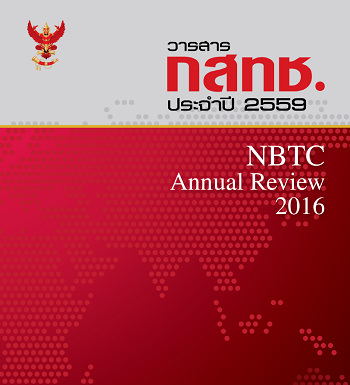การสื่อสารไร้สายระยะใกล้ด้วยแสงที่มองเห็น : เทคโนโลยี การพัฒนา และการขับเคลื่อน
บทคัดย่อ
การนำการสื่อสารด้วยแสงที่มองเห็น หรือวีแอลซีไปประยุกต์ร่วมกับวิธีการสื่อสารที่ในภาคอุตสาหกรรมใช้กันอยู่อย่างกว้างขวางอยู่แล้วให้มีประสิทธิภาพที่ดียิ่งขึ้น เป็นแนวทางหนึ่งที่กลุ่มวิจัยนำเสนอที่สามารถสร้างทางเลือกของเทคโนโลยีการสื่อสารให้กับภาคอุตสาหกรรม นอกจากนี้การลดเวลาในการพัฒนานวัตกรรมหรือสิ่งประดิษฐ์ที่ประยุกต์ใช้การสื่อสารด้วยแสงที่มองเห็นด้วยชุดพัฒนาที่ทางกลุ่มวิจัยได้พัฒนาขึ้นก็เป็นอีกแนวทางหนึ่งที่ส่งเสริมการใช้งานการสื่อสารด้วยแสงที่มองเห็นให้แพร่หลายมากขึ้น จากแนวทางที่กล่าวมากลุ่มผู้วิจัยได้ทดลองประยุกต์การส่งสัญญาณด้วยโปรโตคอลมอดบัสผ่านการสื่อสารแสงที่มองเห็น เพื่อเพิ่มความยืดหยุ่นในการสื่อสารระหว่างอุปกรณ์และเครื่องจักร และลดปัญหาการส่งผ่านข้อมูลในสภาพแวดล้อมที่มีคลื่นแม่เหล็กไฟฟ้ารบกวนสูงได้ โดยใช้ชุดพัฒนาที่ทางทีมวิจัยได้พัฒนาขึ้นเพื่อควบคุมพัดลมไฟฟ้า โดยผลการทดลองสามารถทำได้ตรงตามที่สั่งการควบคุมผ่านหน้าจอควบคุมแบบเอชเอ็มไอทุกประการ
เอกสารอ้างอิง
Modbus, I. D. A. (2004). Modbus application protocol specification v1. 1a. North Grafton, Massachusetts.
PracTel Inc. (2014). Progress in Optical Wireless Communications – VLC and FSO Technologies, Applications and
Markets. Retrieved from https://www.researchandmarkets.com/reports/2813840/progress-in-optical-wireless-
communications-vlc
Haruyama, S. (2010). Visible light communication. In 17th International Display Workshops, IDW'10.
Modicon, I. (1996). Modicon modbus protocol reference guide. North Andover, Massachusetts, 28-29.
Automation, S. (2002). MODBUS over serial line–Specification and Implementation guide. V. Modbus Organization,
Inc.
JEITA. (2013). JEITA visible light communication standards. Retrieved from https://www.jeita.or.jp/japanese
/standard/book/CP-1223.
ดาวน์โหลด
เผยแพร่แล้ว
รูปแบบการอ้างอิง
ฉบับ
ประเภทบทความ
สัญญาอนุญาต
บทความที่ปรากฏในวารสารกิจการสื่อสารดิจิทัล เป็นลิขสิทธิ์ของสำนักงาน กสทช. ซึ่งสำนักงาน กสทช. เปิดโอกาสให้สาธารณะหรือบุคคลทั่วไปสามารถนำผลงานไปเผยแพร่ คัดลอก หรือตีพิมพ์ซ้ำได้ ภายใต้สัญญาอนุญาตแบบเปิด (Creative Commons: CC) โดยมีเงื่อนไขสำหรับผู้ที่นำผลงานไปใช้ต้องระบุอ้างอิงแหล่งที่มา (Attribution: BY) ห้ามดัดแปลง (NoDerivatives: ND) และต้องไม่ใช้เพื่อการค้า (NonCommercial: NC) เว้นแต่ได้รับอนุญาตเป็นลายลักษณ์อักษรจากสำนักงาน กสทช.
อนึ่ง ข้อความ ตาราง และภาพที่ปรากฏในบทความซึ่งได้รับการตอบรับให้ตีพิมพ์และเผยแพร่ในวารสารนี้เป็นความคิดเห็นของผู้นิพนธ์ โดยไม่ผูกพันต่อ กสทช. และสำนักงาน กสทช. หากมีความผิดพลาดใด ๆ ผู้นิพนธ์แต่ละท่านต้องรับผิดชอบบทความของตนเองแต่เพียงผู้เดียว ไม่เกี่ยวข้องกับ กสทช. และสำนักงาน กสทช. แต่ประการใด



